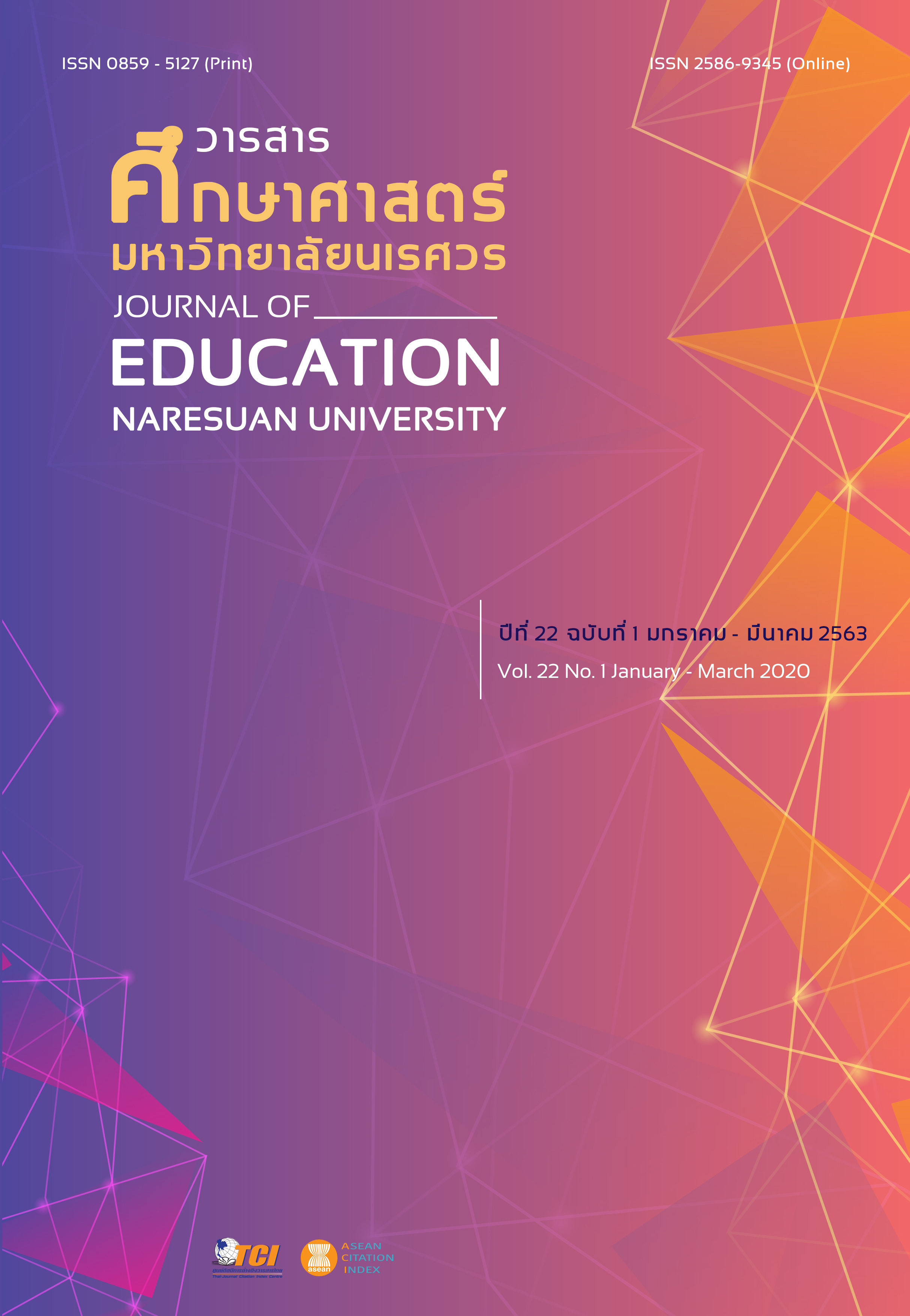AN ACTION RESEARCH ON ENHANCING GIFTED STUDENTS’ COLLABORATIVE PROBLEM SOLVING THROUGH USING CREATIVE PROBLEM SOLVING APPROACH ON STOICHIOMETRY
Main Article Content
Abstract
The aims of this action research were to investigate the ways of using creative problem solving learning model for developing gifted students’ collaborative problem solving competency and to examine the effects of using creative problem solving learning model on gifted students’ collaborative problem solving competency on stoichiometry. The target groups were 35 science gifted students studied in one of the schools in the north of Thailand. In this research, classroom action research was employed. As thus, a PAOR cycle was run for three continuous research cycles. Researcher taught by using learning management plan. The research instruments used were learning management plans, the field note record after learning, the students’ reflection, the collaborative problem solving competency observation form, and the collaborative problem solving competency test. For data analysis, content analysis technique was used along with triangulation for qualitative data. In addition, statistics such as average and percentage was used for analysis quantitative data. The result reveals that after the learning activities in each research cycle, student changed their problem solving behavior with members to the best collaborative way. It was found that after learning all cycles, the students’ competency has reached 97 %, which is indicated at the high level. It was found that the ways of this learning model from developed are consists of six steps as follows: engaging, knowledge exploring, problem understanding, solutions creating, preparing for action, and approach for solving the problem, presentation, debating, and improving. Each step in this model must focus on student solving the problem to successful with group activities.
Article Details
The owner of the article does not copy or violate any of its copyright. If any copyright infringement occurs or prosecution, in any case, the Editorial Board is not involved in all the rights to the owner of the article to be performed.
References
Boonyang, P., Srisanyong, S., & Singlop, S. (2016). A development of learning active package on ecosystem using cooperative learning with STAD technique for grade 9 students. Journal of education Naresuan University, 18(4), 223-237. [in Thai]
Chantavanich, S. (2016). Qualitative research methodology. Bangkok: Chulalongkorn University Press. [in Thai]
Chomphupart, S. (2011). A development of instructional behavior for the creative problem solving of teachers and students at the science gifted students promotion school using emancipatory action research (Doctor dissertation). Bangkok: Srinakharinwirot University. [in Thai]
Chompupong, V. (2013). Effects of cooperative learning package by using jigsaw technic on thailand geography lesson of Matthayomsuksa 1 students, Tessaban 4 School (Chowwanapreechautit). Journal of Veridian E-Journal, 6(2), 597-611. [in Thai]
Crane, P., & Richardson, L. (2000). Reconnect action research kit. Canberra: Department of Family and Community Services.
Chuatong, P. (2013). Using problem-based learning approach to promote grade 11 students’ problem solving ability in topic of solid liquid gas (Master thesis). Phitsanulok: Naresuan University. [in Thai]
Faikumta, C. (2016). Classroom action research in science classroom. Bangkok: Institute of academic development (IAD). [in Thai]
Khammani, T. (2012). Technical for teaching: Knowledge for professional learning process. Bangkok: Darnsuthakan Press. [in Thai]
Kijkuakul, S. (2014). Science learning management and direction for 21st century teachers. Phetchabun: Julladis Publisher. [in Thai]
Klainin, S. (2012). Thai science education: Development and recession. Samut Prakan: Advance printing survice. [in Thai]
OECD. (2007). PISA 2006: Science competencies for tomorrow’s world. Paris: OECD.
OECD. (2013). PISA 2015 draft collaborative problem solving framework. Paris: OECD.
Office of the Education Council. (2009). Educational proposals reform in the second decade (2nd ed.). Bangkok: Prikwarn Graphic. [in Thai]
Office of the National Economics and Social Development Board. (2016). The twelve National Economic and Social Development Plan (2017-2021). Bangkok: Office of the National Economics and Social Development Board. [in Thai]
Partnership for 21st Century Skills. (2011). Framework for 21st Century learning. Retrieved from https://www.p21.org/storage/documents/docs/P21_Framework_Definitions_New_Logo_2015.pdf
Panich, V. (2013). Method for building the learning of students in 21st century. Bangkok: Saritwong Foundation. [in Thai]
Rosen, Y., & Foltz, P. W. (2014). Assessing collaborative problem solving through automated technologies. Research and Practice in Technology Enhanced Learning, 9(3), 389-410.
Sintuvong, K. (1994). Basic of educational psychology for teaching in science. Nonthaburi: Sukhothai Thammathirat University. [in Thai]
The Institute for The Promotion of Teaching Science and Technology. (2012). Curriculum structure of universal standard enrichment science classroom in high school on model of the institute for the promotion of teaching science and technology. Bangkok: The Institute for The Promotion of Teaching Science and Technology. [in Thai]
Thongraya, K. (2014). The organizing learning activities in collaborative instructional model by student teams achievement divisions cooperation in groups to promote the computer learning achievement of students in grade 6 (Master thesis). Bangkok: Rajamangala University of Technology Thanyaburi. [in Thai]
Treffinger, et al. (2010). Creative Problem Solving (CPS Version 6.1™) a contemporary framework for managing change. Retrieved from www.cpsb.com/resources/downloads/public/CPSVersion61B.pdf


